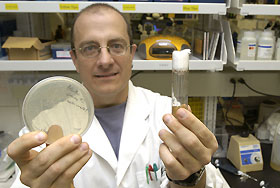|
This is an archived article.
For the latest news, go to the Advance Homepage
For more archives, go to the Advance Archive/Search Page. |
||
|
Health Center Study May Help Scientists
Scientists at the Health Center have discovered a method of detecting genes whose basic information is changed along the route to becoming protein.
The process is called RNA editing, and awareness of it now allows a rational approach to finding genes that are edited. The research will significantly increase understanding of gene recoding information in genome sequences and could prove to be a knowledge expressway for scientists trying to understand nervous system disorders such as Parkinson's Disease and epilepsy. The work was performed by Robert Reenan, an associate professor of genetics and developmental biology, and lab members Barry Hoopengardner, Tarun Bhalla, and Cindi Staber. The Health Center scientists used comparative genomics, a branch of evolutionary biology that compares the genomes of different organisms: specifically, Reenan and his colleagues compared fruit fly, mouse, rat, and human genomes in order to identify a human gene that is recoded by editing. Reenan says the research has long-term implications and will contribute to advanced diagnostics and perhaps lead to treatments for some neurological disorders. Proteins are required for the structure, function, and regulation of the body's cells, tissues, and organs. For cells to manufacture protein, they must first copy the segment of the gene's DNA that holds the blueprint or "coding" for the protein. This copy, which consists of a single strand of RNA, is called messenger RNA, or "mRNA." The working mRNA copy is sometimes modified, or "recoded," as it is formed. Recoding - RNA editing - is much like photocopying a recipe from a cookbook and writing changes on the photocopy rather than on the book's pages. The revisions on the copy would then be used to prepare the food, but the original recipe in the book would remain unchanged. When DNA is converted to RNA during the protein-making process, an enzyme converts adenosine to the nucleoside inosine by a process called "A-to-I" RNA editing. RNA editing has been known for more than a decade in animals but, until now, edited genes have always been discovered by chance. "The one thing that becomes clear about the RNA editing sites is that they're all different; there was no way to predict where an RNA editing site would occur from genome sequence," Reenan says. "We hoped to get clues about RNA editing by comparing genomes of different species." Those clues appeared as the researchers compared more than 900 genes between two species of the fruit fly Drosophila. Expanding the research into mouse and rat genomes, they found a signature in genomic DNA in genes shared between species where RNA transcription products are destined to be edited by the enzyme adenosine deaminase. "The signature we found was an unexpectedly high level of DNA sequence identity between species," he said. That signature reliably identifies genes that are recoded during transcription. The identification provided scientists with a means to predict the occurrence of editing. Moreover, Reenan and his team found that such recoding is largely confined to the nervous system across species, and pinpointed a target of the process in humans. The new study is surprising in accurately predicting editing in a number of genes, as well as the nature of the genes that undergo editing. The researchers discovered that all of the new genes that are recoded are involved in fast electrical and chemical signaling in the brains of flies and mammals, including humans. "We know that RNA editing is very important for the function of animal brains, since mutant flies and mice that do not perform editing have extreme neurological disorders," Reenan says. "What we didn't realize was the extent of nervous system involvement - the centrality, in terms of brain function, of the genes involved. "The proteins targeted by editing are basically the machinery that allow nervous systems to function on a timescale of milliseconds, which is not a demand placed on every organ," he said. The prominence of nervous system genes involved in this process makes the discovery of RNA editing defects in the etiology of nervous system disorders "almost certain," Reenan says. With knowledge of the signature and recognition that A-to-I RNA editing occurs primarily in nervous systems, scientists can now more closely examine how recoding affects expression by nervous system-specific genes, including those responsible for epilepsy and Parkinson's Disease. "The original aspect of Dr. Reenan's research is that he and his colleagues started with the fruit fly model system and identified new and important molecules that are modified in the brains of other organisms, including man," says Marc Lalande, chair of the developmental biology and genetics department. "He used his knowledge and expertise in molecular genetics and neurobiology, together with a very original way of analyzing computerized genomic data, to make a seminal discovery concerning brain function. This is really novel and exciting research." |

